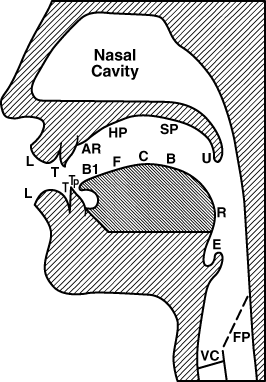Distribution of Speech Sounds
The set of phonetic environments in which a phone occurs
- In English, vowels preceding a nasal consonant become nasalized
bead [bid] bead [bĩn]
pit [phIt] pin [phĨn]
- In English, voiceless stops –/p/, /t/, /k/ -in word-initial position become aspirated
top [thap] stop [stap]
pot [pht] spot [spat]
cop [khap] Scot [skat]
- In English, voiceless stops –/p/, /t/, /k/ - in word-final position, at the end of an utterance, can be unreleased.
mop [map΄] Where’s the mop?
bit [bIt΄] Can I have a bit?
pick [phIk΄] That’s a nice pick.
- In English, velar stops –/k/, /g/ - preceding a front vowel become palatilized
keep [ķhip(΄)] cop [khap(΄)]
gate [gejt(΄)] goat [gowt(΄)]
- In English, alveodental stops –/t/, /d/ - following a stressed vowel and preceding an unstressed vowel can be pronounced as flaps
b΄itter [bIDґ]
b΄idder [bIDґ]
Contrastive Distribution
A pair of phones is contrastive if interchanging the two, results in a new word
- The sounds occur in the same environment, and
- Contrast meanings - make different words
- They are Different Phonemes
- In English: /p/ vs. /b/ à pat vs. bat /p/ with its phonetic variants [ph], [p], [p(΄)] is a distinct phoneme
- In Hindi: /ph/ vs. /p/ à [phәl] ‘fruit’ vs. [pәl] ‘moment’ /p/ and /ph/are distinct phoneme in English: /l/ vs. /r/ à leaf vs. reef /l/ and /r/ are distinct phonemes
Complementary Distribution
- Two sounds in complementary distribution are in mutually exclusive distributions
- The sounds always appear in different phonetic environments
- Phones in complementary distribution are allophones of the same
Phoneme.
- In English: /p/
· [ph] aspirated in word-initial position
· [p] unaspirated when following /s/ /k/
· [ķh] palatalized in word-initial position before a front vowel kit
· [kh] aspirated in word-initial position preceding other vowels cop
· [ķ] palatalized preceding front vowels skip
· [k] in other environments Scot/i/
· [ĩ] nasalized before a nasal consonant pin
· [i] oral (non-nazal) in all other environments pit
- In Korean: [l] vs. [r]
· [r] occurs between vowel
· [l] never occurs between vowels
Free Variation
- Variants of a phoneme that can replace one another in exactly the same environment are called free variants.
- There is a tremendous amount of free variation in speech which goes entirely unnoticed
- In English: the alternation between word-final released and non-released stops is an example of free variation
- Word-final stops can be optionally non-released at the end of an utterance à [p(΄)] - [map(΄)]
The set of phonetic environments in which a phone occurs
- In English, vowels preceding a nasal consonant become nasalized
bead [bid] bead [bĩn]
pit [phIt] pin [phĨn]
- In English, voiceless stops –/p/, /t/, /k/ -in word-initial position become aspirated
top [thap] stop [stap]
pot [pht] spot [spat]
cop [khap] Scot [skat]
- In English, voiceless stops –/p/, /t/, /k/ - in word-final position, at the end of an utterance, can be unreleased.
mop [map΄] Where’s the mop?
bit [bIt΄] Can I have a bit?
pick [phIk΄] That’s a nice pick.
- In English, velar stops –/k/, /g/ - preceding a front vowel become palatilized
keep [ķhip(΄)] cop [khap(΄)]
gate [gejt(΄)] goat [gowt(΄)]
- In English, alveodental stops –/t/, /d/ - following a stressed vowel and preceding an unstressed vowel can be pronounced as flaps
b΄itter [bIDґ]
b΄idder [bIDґ]
Contrastive Distribution
A pair of phones is contrastive if interchanging the two, results in a new word
- The sounds occur in the same environment, and
- Contrast meanings - make different words
- They are Different Phonemes
- In English: /p/ vs. /b/ à pat vs. bat /p/ with its phonetic variants [ph], [p], [p(΄)] is a distinct phoneme
- In Hindi: /ph/ vs. /p/ à [phәl] ‘fruit’ vs. [pәl] ‘moment’ /p/ and /ph/are distinct phoneme in English: /l/ vs. /r/ à leaf vs. reef /l/ and /r/ are distinct phonemes
Complementary Distribution
- Two sounds in complementary distribution are in mutually exclusive distributions
- The sounds always appear in different phonetic environments
- Phones in complementary distribution are allophones of the same
Phoneme.
- In English: /p/
· [ph] aspirated in word-initial position
· [p] unaspirated when following /s/ /k/
· [ķh] palatalized in word-initial position before a front vowel kit
· [kh] aspirated in word-initial position preceding other vowels cop
· [ķ] palatalized preceding front vowels skip
· [k] in other environments Scot/i/
· [ĩ] nasalized before a nasal consonant pin
· [i] oral (non-nazal) in all other environments pit
- In Korean: [l] vs. [r]
· [r] occurs between vowel
· [l] never occurs between vowels
Free Variation
- Variants of a phoneme that can replace one another in exactly the same environment are called free variants.
- There is a tremendous amount of free variation in speech which goes entirely unnoticed
- In English: the alternation between word-final released and non-released stops is an example of free variation
- Word-final stops can be optionally non-released at the end of an utterance à [p(΄)] - [map(΄)]

Comments
Post a Comment